Tom Boles dicovers Supernova number 129!
 Sunday, March 7, 2010 at 10:41PM
Sunday, March 7, 2010 at 10:41PM Tom Boles discovered the Supernova below on Thursday 4th March. Here is an image I took of it on March 7th.
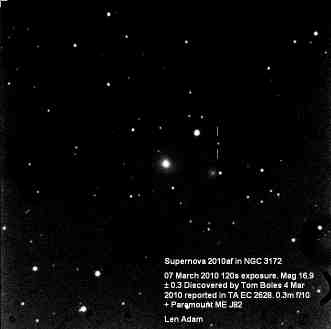
 [Your Name Here] | Comments Off |
[Your Name Here] | Comments Off |
Ford's excellent
monthly calendar
ABOUT THE WEBSITE - CLICK HERE
My Telescopes
My Main Telescope - C14 and Paramount ME
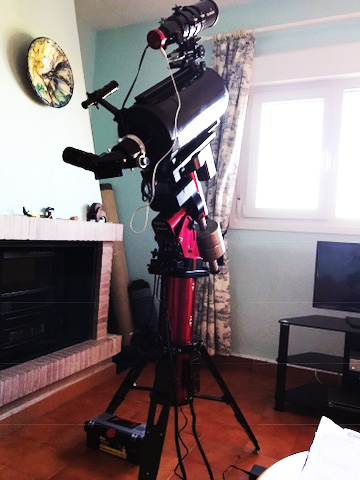
My new Paramount MyT and 8-inch Ritchey-Chretien Telescope
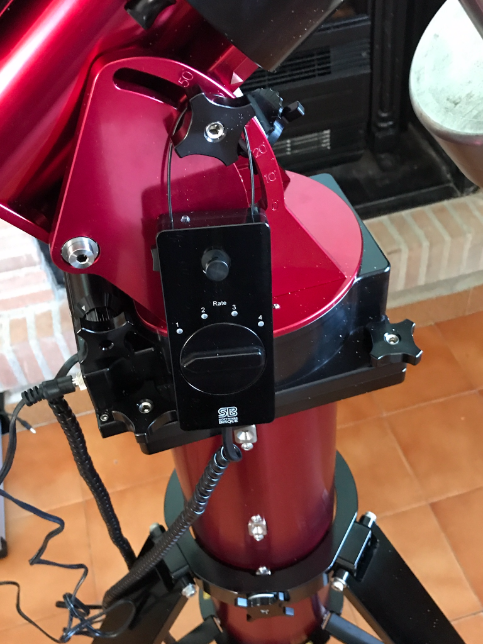
MyT Hand Controller
My Meade 12 inch SCT on a CGEM (Classic) Mount
My 4 inch Meade Refractor with Sky Watcher Guidescope and ZWO camera on a CGEM (Classic) Mount
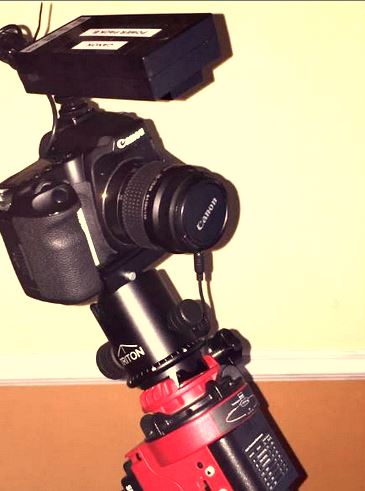
Skywatcher Star Adventurer Mount with Canon 40D
My Solar setup using a DSLR and Mylar Filter on my ETX90

DSLR attached to ETX90. LiveView image of 2015 partial eclipse on Canon 40D
I try to log my observing and related activities in a regular blog - sometimes there will be a delay but I usually catch up. An index of all my blogs is on the main menu at the top of the page with daily, weekly or monthly views. My Twitter feed is below. I am also interested in photograping wildlife when I can and there is a menu option above to look at some of my images. I try to keep the news feeds from relevant astronomical sources up to date and you will need to scroll down to find these.
The Celestron 14 is mounted on a Paramount ME that I have been using for about 10 years now - you can see that it is mounted on a tripod so is a portable set up. I still manage to transport it on my own and set it all up even though I have just turned 70! It will run for hours centering galaxies in the 12 minute field even when tripod mounted.
 Sunday, March 7, 2010 at 10:41PM
Sunday, March 7, 2010 at 10:41PM Tom Boles discovered the Supernova below on Thursday 4th March. Here is an image I took of it on March 7th.

 Sunday, February 28, 2010 at 9:49PM
Sunday, February 28, 2010 at 9:49PM I have been adding galaxies from Abell Clusters to my Galaxy Search Library. This was one of the Galaxies - NGC 891. Here is the information for NGC 891 provided by The Sky
Object name: NGC 891
Magnitude: 10.1
Equatorial: RA: 02h 23m 12s Dec: +42°23'48"(current)
Equatorial 2000: RA: 02h 22m 33s Dec: +42°20'50"
Horizon: Azim: 298°06'43" Alt: +33°09'00"
Size: 11.7 x 1.6
Transit time: 16:01 Always above horizon.
Object type: Spiral Galaxy
Source catalog: Revised NGC
Blue mag: 10.9
Constellation: AND
Surface brightness: 13.1
Remarks: IRAS02195+4209
Dreyer description : Remarkable! Bright, very large, very moderately extended 22°.
Position angle: 22°00'
Hour angle: 05h 58m 09s
Air mass: 1.83
Sidereal time: 08:21
Click distance: 0.0000
Catalog number: 891
Celestial type: 8
NGC/IC: 0
Catalog: 1
 Saturday, February 20, 2010 at 12:02PM
Saturday, February 20, 2010 at 12:02PM Friday night (19th February) was clear until about 1130 p.m. I managed to image over 100 galaxies. It is so much easier now with the centred images but I have a long way to go to build up a sufficient library of reference galaxies with so few clear nights here. I have been experimenting with synching into the T-Point model to see the effect. This is not a recommended approach but I believe that it is quite an effective method of keeping objects centred. I think the ideal way of adding points to the T Point model is to take an image, solve the plate and then synch into the T Point model if necessary or map on the image link centre rather than spend time centring a star and mapping that. If you have a good plate solution this is extremely accurate and also avoids identification errors – it just does not matter where you are pointing. This was the first random area of sky that I imaged, synched on the image link centre and mapped into the model.
(Unknown 1)
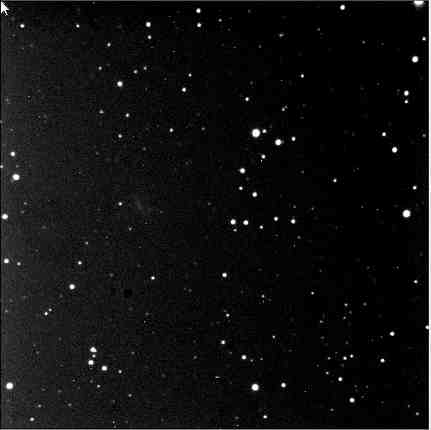
Carrying out a plate solution gave 19 stars used with an RMS position error of 0.09 arcseconds.
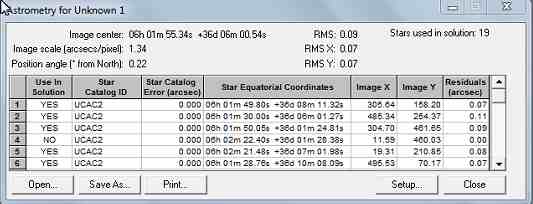
Here are the above image and the chart produced by the Sky to confirm the pattern recognition
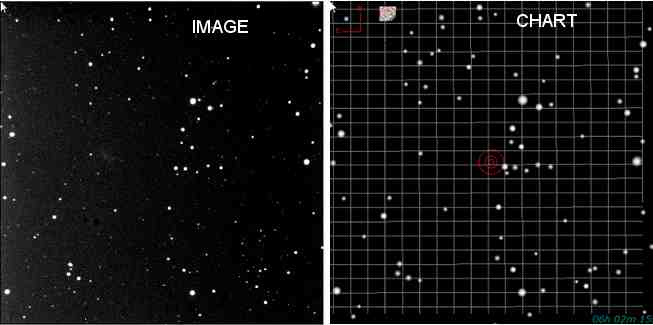
I now added labels from "The Sky" which identifies many of the stars on my original image.
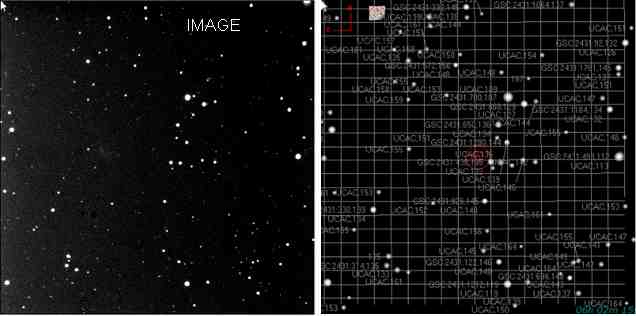
The image link information in the table below gives me the actual centre of the image (i.e. where the telescope is actually pointing so by Synching on this position corrects the pointing error on the telescope at those coordinates.
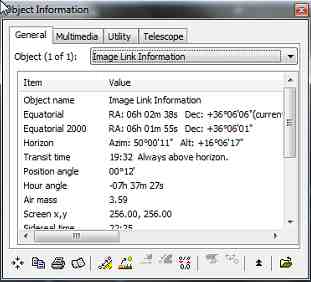
So once the Synch was carried out all successive images that night (100 plus) were exactly centred.
 Monday, January 18, 2010 at 12:11PM
Monday, January 18, 2010 at 12:11PM No - I haven't bought a new telescope - the power of laser technology has upgraded my distance vision to one line better than 20/20!
The operation was on the 2nd January and I am now able to see the stars with the naked eye as actual points of light for the first time in my life! Unfortunately I still have to wear reading glasses - an age thing I am afraid! Strangely I can also see the colour of the stars more clearly - Aldebaran and Betelgeuse are really red.
I have to be careful for a few weeks but the improvement was immediate.
A few days after the operation I performed a mapping run (following the laptop failure) that now has the telescope centering objects in the 11x11 minute field of view. (125 stars mapped).

The objects are centred to within about 45 seconds of arc in the region of sky (i.e. just left of the meridian) that I use for supernova searching. Last night (17th Jan 10) I tried to precisely North align the camera but clouds kept appearing and I abandoned it for the next clear opportunity. The images were solving nicely with over 20 star matches which were able to tell me the current camera position angle. Once that is done I can resume my searching.
I am looking forward to my trip to Almeria in Spain in April to assess the skies there and will be taking my ETX 90. Hopefully I will be able to try it out with my DSLR to take some images. Almeria is the driest part of Europe (Lawrence of Arabia and the Spaghetti westerns were filmed there - as well as Raiders of the Lost Ark I believe). I am driving down with Harry the Westie!

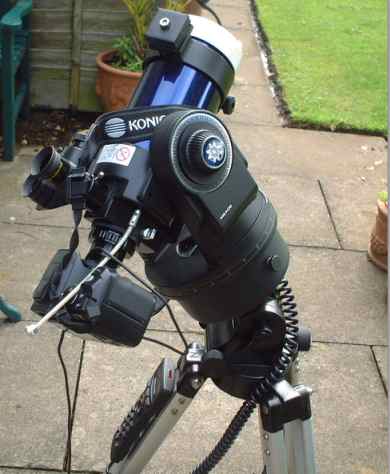
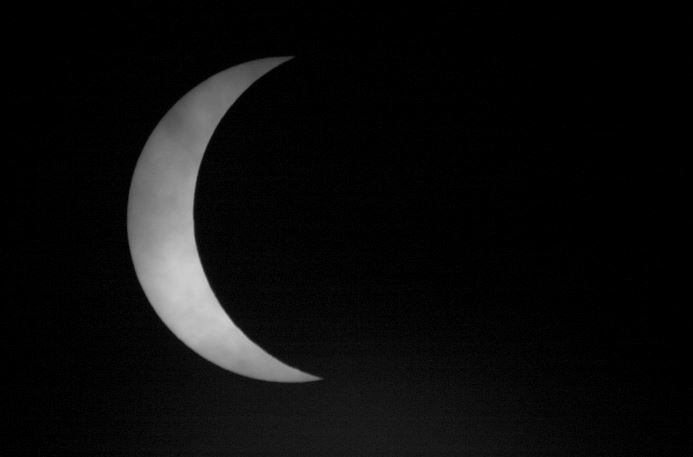
I have really only used the ETX for partial eclipses - it worked really well for that - short exposures only of course. I purchased the ETX on ebay (also where I bought my car) and got a very good system that had had all the "tuning" following I believe Mike Weasner's suggestions to tighten it up. The package included balance weights for a camera and a solar filter (mylar type). My DSLR worked very well with this to give some good images.
 Tuesday, December 15, 2009 at 7:09AM
Tuesday, December 15, 2009 at 7:09AM Unfortunately my telescope pointing had been lost so I have had to start again with TPoint to map stars so that corrections for the mechanical imperfections of the mount can be calculated and corrected for. I need to have the target in the centre of the image every time so that the image can be blinked with the library master. I have also changed to f/10 which gives me an image that is 11.43 minutes square requiring greater pointing accuracy so I am trying to get the polar alignment to be more accurate so that it points at the refracted pole. I have had 3 runs at the mapping with 17 stars per run having applied the 6 fixed terms and 4 harmonic terms. TPoint is now indicating that the telescope is pointing 23 seconds of arc above the pole whereas I estimate by interpolation that I need this to be 44.76 arcseconds for my latitude.
 Sunday, November 29, 2009 at 1:06PM
Sunday, November 29, 2009 at 1:06PM Disaster struck last week when my dome laptop refused to switch on and was deemed to be not worth repairing. Fortunately all data was saved but I had to purchase a new one. Much time was spent in reloading software onto the new Windows 7 computer. As always not everything worked at first causing some stress. Updating the Software Bisque (SB) software to the latest versions and looking at Windows 7 issues discussed on the SB forums eventually resolved these problems. Now all I need is a clear night to be able to check that the telescope pointing has been maintained.

 Sunday, November 15, 2009 at 11:51AM
Sunday, November 15, 2009 at 11:51AM I was taken by surprise last night (14th November) when I discovered that it was clear at 11pm - I should have checked earlier!! However I managed to align the camera properly before the inevitable clouds set in at 1 a.m.
The new external focuser is shown below

The thumbscrew on the top of the focuser can be loosened to allow the entire focuser and attached camera to rotate to get the camera aligned to have North at the top.
The image above shows the Crayford Focuser attached to the LX200 and to the camera.
The Crayford now takes over the focusing role from the LX200 and so the mirror is clamped as shown in the image below which shows the fully (firmly but not putting any stress on the mirror) tightened spring on the focus lock.
Images were taken to determine the Position Angle - this is the first image of Globular Cluster Herschel - H201-1.

The plate solution gives a Position Angle of 1.98 degrees.
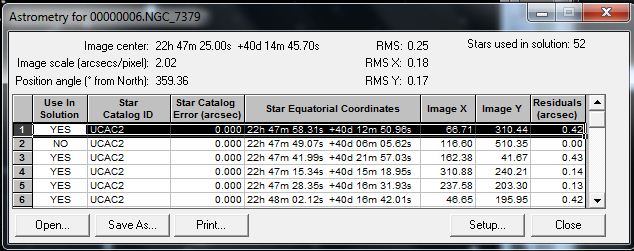
I adjusted the Position Angle once more - took a random image - and solved the plate.
Here are the actual image and "The Sky" solution.
As you can see the alignment with North is good - as the North arrow is vertical
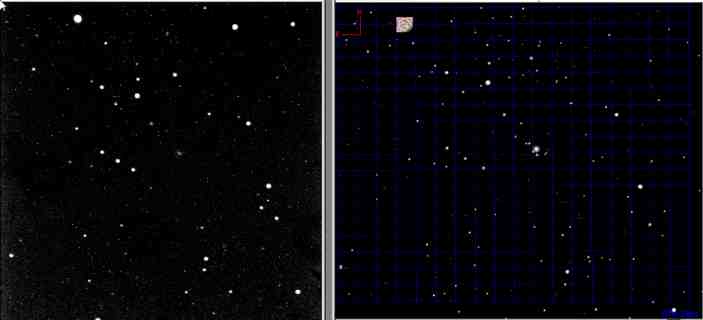
The Plate Solution gives the detail
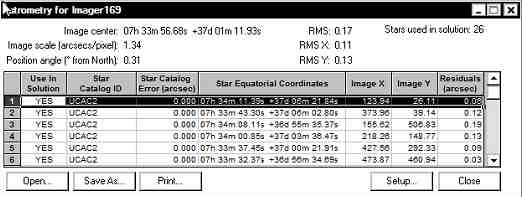
The position angle is now 0.31 degrees - this is near enough!!
 Saturday, November 14, 2009 at 5:30PM
Saturday, November 14, 2009 at 5:30PM At my normal focal ratio of f.6.3 images are approximately 20 minutes square which gives a good field of view but means that many galaxies are quite small. Also there does tend to be vignetting of the image. Whilst incorporating a new external focuser to get around image shift problems I thought I would try imaging at f/10 and check the practicality of centring the images (at the smaller field of view) for a galaxy run. On 9th Nov the sky was clear with drifting cloud which eventually became thick cloud - limiting the test. I tried it out with one object - NGC 744 - see the image below.
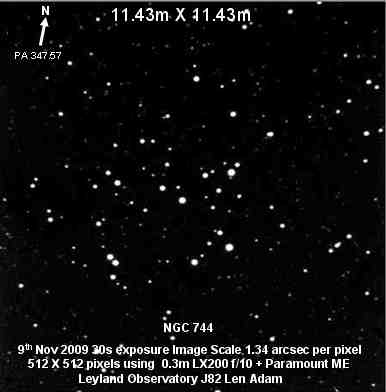
Clearly it is quite well centred. Here is the Deep Sky Survey Image - courtesy of The STScI Digitized Sky Survey.
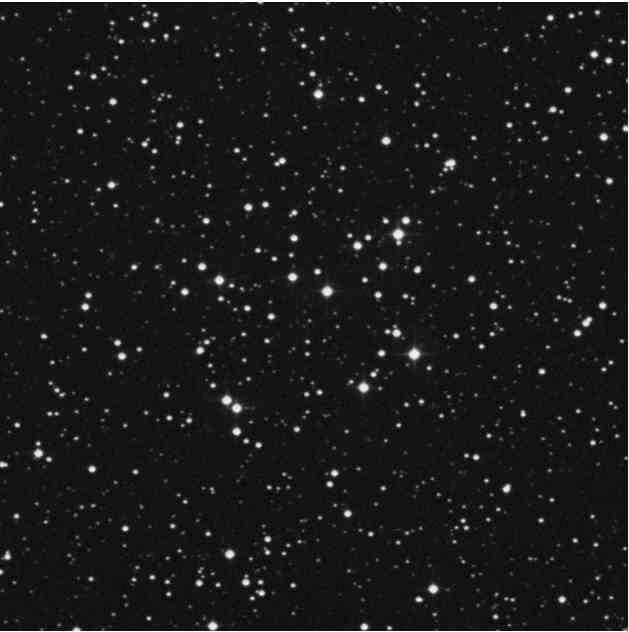
The above image was obtained from STScI by completing the table below
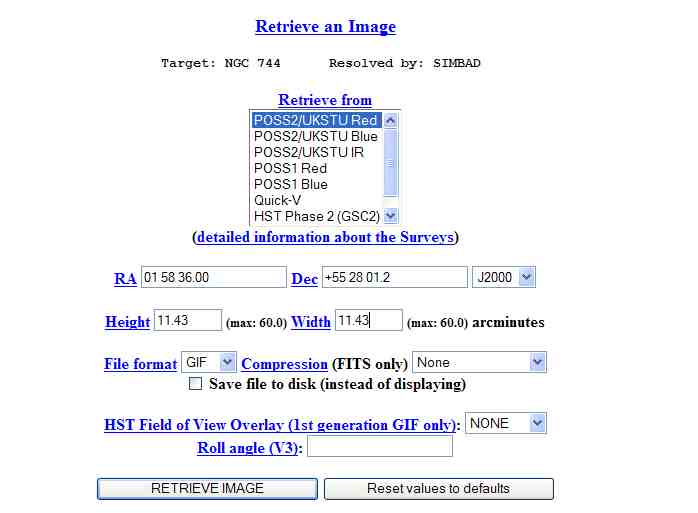
The plate solution is shown here - 21 matched stars - RMS 0.08 which is a good astrometric solution.
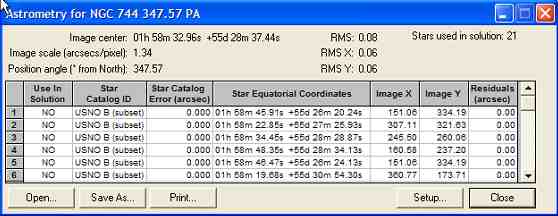
This (as represented in the first image above) shows that the camera is not North aligned - the Position Angle is given as 347.57 degrees. There was not time to rotate the camera to the 360 or 0 degree position as clouds set in. The matched stars on the image are shown here.
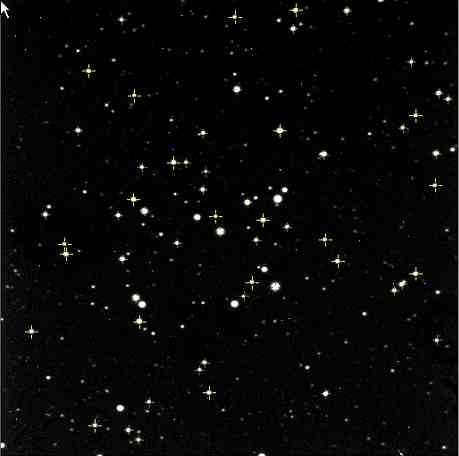
This is the image plotted onto the Sky Chart solution showing that it is indeed NGC 744
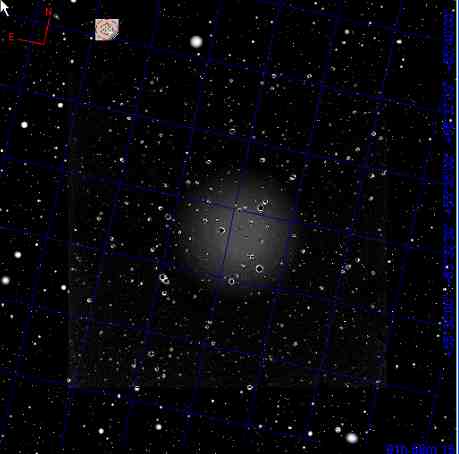
and the Object Information Box

and the exact match of the Sky chart to the image. Note the direction of North corresponding to the discussion above.
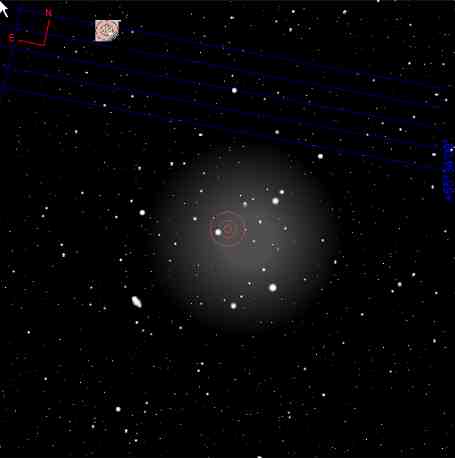
 Friday, October 16, 2009 at 11:45PM
Friday, October 16, 2009 at 11:45PM I managed to image 329 Galaxies tonight - some of which were obscured by cloud I might add which drifted by from time to time!
 Monday, October 12, 2009 at 11:59PM
Monday, October 12, 2009 at 11:59PM I managed to image 345 galaxies on this run but many were of poor quality because of the low altitude and associated haze and light pollution.